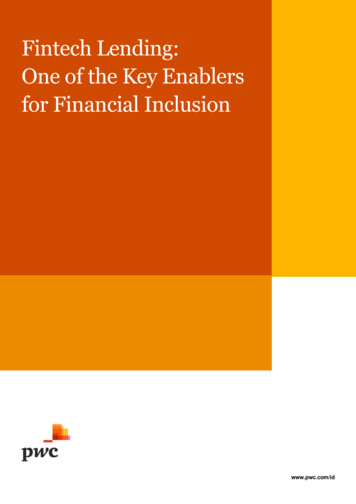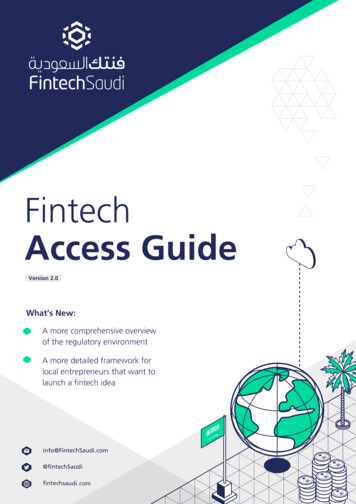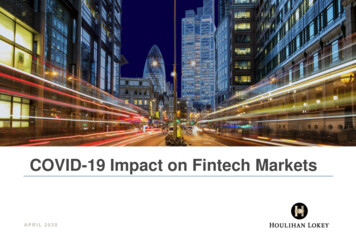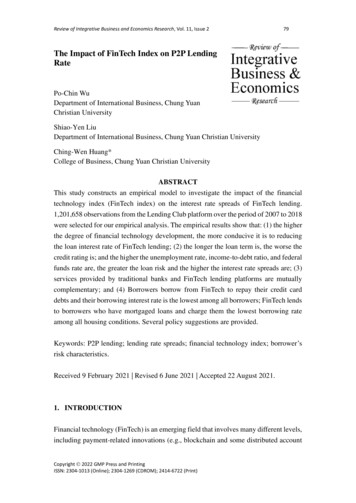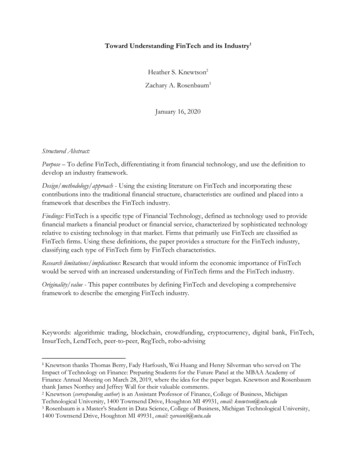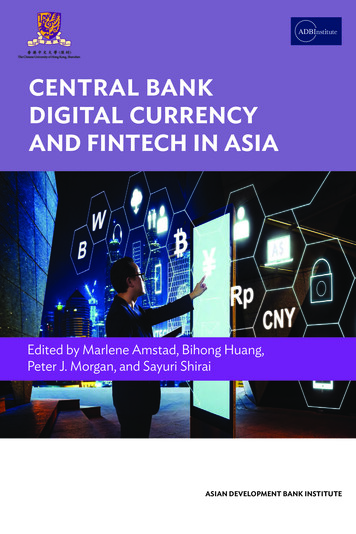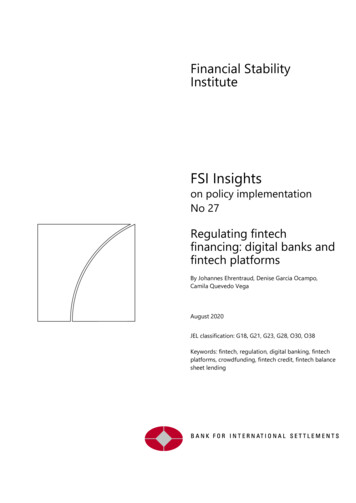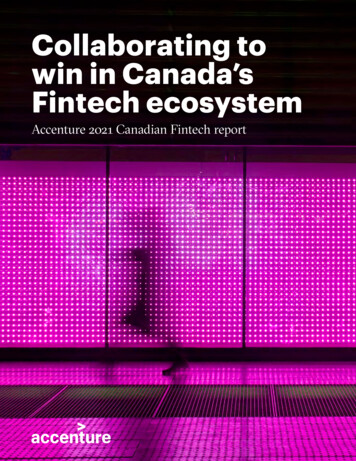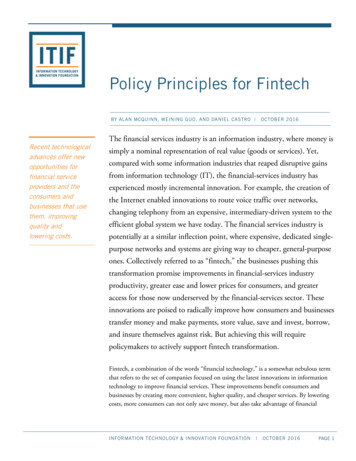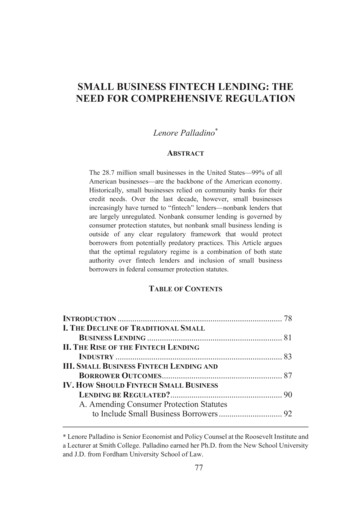
Transcription
SMALL BUSINESS FINTECH LENDING: THENEED FOR COMPREHENSIVE REGULATIONLenore Palladino*ABSTRACTThe 28.7 million small businesses in the United States—99% of allAmerican businesses—are the backbone of the American economy.Historically, small businesses relied on community banks for theircredit needs. Over the last decade, however, small businessesincreasingly have turned to “fintech” lenders—nonbank lenders thatare largely unregulated. Nonbank consumer lending is governed byconsumer protection statutes, but nonbank small business lending isoutside of any clear regulatory framework that would protectborrowers from potentially predatory practices. This Article arguesthat the optimal regulatory regime is a combination of both stateauthority over fintech lenders and inclusion of small businessborrowers in federal consumer protection statutes.TABLE OF CONTENTSINTRODUCTION . 78I. THE DECLINE OF TRADITIONAL SMALLBUSINESS LENDING . 81II. THE RISE OF THE FINTECH LENDINGINDUSTRY . 83III. SMALL BUSINESS FINTECH LENDING ANDBORROWER OUTCOMES . 87IV. HOW SHOULD FINTECH SMALL BUSINESSLENDING BE REGULATED?. 90A. Amending Consumer Protection Statutesto Include Small Business Borrowers . 92* Lenore Palladino is Senior Economist and Policy Counsel at the Roosevelt Institute anda Lecturer at Smith College. Palladino earned her Ph.D. from the New School Universityand J.D. from Fordham University School of Law.77
78FORDHAM JOURNALOF CORPORATE & FINANCIAL LAW[Vol. XXIVB. State Regulation and Licensing of Fintech Lenders . 96C. Office of the Comptroller of the CurrencySpecial Purpose Nonbank Charter Program. 99CONCLUSION . 103INTRODUCTIONThe 28.7 million small businesses in the United States—99% of allAmerican businesses1—are the backbone of the American economy.2 Thedefinition of a “small business” varies, but if we consider businesses withunder 500 employees, they employ over half of all American workers andare drivers of economic prosperity.3 Historically, small businesses reliedon banks—particularly community banks—to fulfill their credit needs.Over the last decade, small businesses increasingly have been obtainingcredit from “fintech” lenders—nonbank lenders that are largelyunregulated. “Fintech,” or financial technology, refers to technologyfirms that provide lending services outside of the traditional regulatedbanking context, using algorithmic decision-making processes rather thantraditional credit scores and income verification.4 While the rise of fintechlenders may open up credit opportunities to new borrowers, their rates and1. “Small businesses” comprise a generically large category: if defined by allbusinesses with fewer than 500 employees, small businesses comprise 99% of all U.S.businesses and half of the American private-sector workforce. JPMorgan Chase & Co.Inst., Small Business Data Dashboard (Sept. 2016), board.pdf[https://perma.cc/G3V6-X2PA]. See generally Diana Farrell & Chris Wheat, THE UPSAND DOWNS OF SMALL BUSINESS EMPLOYMENT: BIG DATA ON PAYROLL GROWTH ANDVOLATILITY (JPMORGAN CHASE & CO. INST., 2017); Mark E. Schweitzer & BrettBarkley, Is “Fintech” Good for Small Business Borrowers? Impacts on Firm Growthand Customer Satisfaction (Fed. Res. Bank of Cleveland, Working Paper No. 17-01,2017).2. Out of 28.7 million small businesses, 5.7 million are Main Street businesses,small- and medium-size suppliers to larger corporations, and high-growth startups.JPMorgan Chase & Co. Inst., supra note 1. See generally Karen G. Mills & BraydenMcCarthy, The State of Small Business Lending: Innovation and Technology and theImplications for Regulations 2 (Harv. Bus. Sch., Working Paper No. 17-042, 2016).3. Small businesses are the source of 60% of the net new jobs over the last twodecades. See Mills & McCarthy, supra note 2, at 3, 14.4. Though fintech is also growing inside traditional banking institutions as a wayof conducting businesses, this Article focuses on the distinct nonbank entities thatconduct lending, even though many nonbank fintech entities do partner with banks.
2018]SMALL BUSINESS FINTECH LENDING:THE NEED FOR COMPREHENSIVE REGULATION79terms are often worse, and satisfaction with the borrowing experience islower, as compared to traditional bank borrowing.5 Fintech lending is nota niche sector; the U.S. Government Accountability Office (GAO)projects that the market could grow up to 122 billion by 2020.6While non-bank consumer lending is governed by consumerprotection statutes, non-bank small business lending is currently outsideof any clear regulatory framework that would protect borrowers frompotentially predatory practices. 7 The fact that a fintech borrower iscovered by consumer protection statutes when he borrows 100,000 toremodel his house, but not when he borrows to capitalize his business,motivates the argument that small business borrowers should be coveredunder the consumer protection statutes. Small business borrowersgenerally do not have the sophistication of large commercial borrowersand have more in common with consumer borrowers than with largebusinesses.8 The Treasury Department under the Obama Administrationgave support to this perspective: “strong evidence indicates that smallbusiness loans under 100,000 share common characteristics withconsumer loans yet do not enjoy the same consumer protections.”9 Smallbusiness borrowers are not covered under the consumer protectionstatutes that require clear disclosure of often-opaque lending terms, andthat allow regulators to hold predatory behavior accountable.10Fintech lending can, in principle, be a vital new source of credit toAmerica’s small businesses. Nonbank fintech borrowing increasedbecause bank lending was severely constricted after the financial crisis,5. FED. RES. BANKS, 2017 SMALL BUSINESS CREDIT SURVEY: REPORT ONEMPLOYER FIRMS iv, 18 (2018).6. U.S. GOV’T ACCOUNTABILITY OFFICE, GAO-18-254, FINANCIAL TECHNOLOGY:ADDITIONAL STEPS BY REGULATORS COULD BETTER PROTECT CONSUMERS AND AIDREGULATORY OVERSIGHT 7 (2018).7. At least five federal agencies have authority over traditional bank lending, alongwith state regulators, including the Federal Reserve Board, the Federal Deposit InsuranceCorporation, the Office of the Comptroller of the Currency, the Consumer FinancialProtection Bureau, and the National Credit Union Administration. Letter from Am. forFin. Reform, to U.S. Senate (Apr. 14, 2017) (on file with author).8. See Barbara J. Lipman & Ann Marie Wiersch, Alternative Lending Through theEyes of “Mom & Pop” Small-Business Owners: Findings from Online Focus Groups 5(Fed. Res. Bank of Cleveland 2015).9. U.S. DEPT. OF TREASURY, Opportunities and Challenges in Online MarketplaceLending 28 (2016).10. SPENCER M. COWAN, PATTERNS OF DISPARITY: SMALL BUSINESS LENDING IN THECHICAGO AND LOS ANGELES-SAN DIEGO REGIONS 30 (Woodstock Inst. 2017).
80FORDHAM JOURNALOF CORPORATE & FINANCIAL LAW[Vol. XXIVespecially for the small-dollar loans ( 250,000 and under) that smallbusinesses typically seek.11 Seventy-five percent of loan applications bysmall businesses are for amounts under 250,000; 55% are for amountsunder 100,000.12 The ongoing consolidation of the banking sector, inwhich larger banks are absorbing community banks, combined with thedecline in small-dollar loan offerings by larger banks, created space in thelast decade for fintech lending to thrive in the small business lendingspace. At the same time, technology advances allowed the advent of thelarger nonbank financial marketplace. New firms use alternative datasources and “big data”-driven algorithms to evaluate creditworthiness.13What is different about the fintech borrower experience? Unlikeregulated brick-and-mortar banks, fintech firms provide and underwriteloans online. There are no standardized disclosure requirements or loanterms. Several studies have shown interest rates to be higher than those ofcomparable bank loans.14 There is a risk that unregulated lending to smallbusinesses could be predatory and unsustainable. 15 Small businessesreport high levels of dissatisfaction with fintech lenders, as compared tobank lending, particularly regarding transparency of terms and the priceof the loan.16 Credit is a double-edged sword: small and new businessesneed access to credit to survive, but risky credit that small companiescannot afford, or do not understand the terms of, can be devastating. Highinterest payments can drive small businesses into bankruptcy.A clear regulatory framework has been slow to catch up to theindustry’s growth. As this Article will argue, the optimal regulatoryregime is a combination of state authority and inclusion of small businessborrowers (whose loans are below a certain threshold) in consumerprotection statutes. State regulators should have the ability to regulatefintech lending to small businesses, building on a robust and diverse setof state policies governing nonbank financial entities. Alongside state law11.12.13.See Mills & McCarthy, supra note 2, at 5-6.FED. RES. BANKS, supra note 5, at 6.See Julapa Jagtiani & Catharine Lemieux, Fintech Lending: Financial Inclusion,Risk Pricing, and Alternative Information 7 (Fed. Res. Bank of Phila., Working PaperNo. 17-17, 2017).14. See, e.g., id. at 10. See also discussion infra Section III.15. See Mills & McCarthy, supra note 2, at 86; see also U.S. GOV’TACCOUNTABILITY OFFICE, GAO 11-613, REPORT TO CONGRESSIONAL COMMITTEES:PERSON-TO-PERSON LENDING: NEW REGULATORY CHALLENGES COULD EMERGE AS THEINDUSTRY GROWS 31 (2011).16. FED. RES. BANKS, supra note 5, at 14.
2018]SMALL BUSINESS FINTECH LENDING:THE NEED FOR COMPREHENSIVE REGULATION81and regulatory authority, the consumer statutes that are overseen by theConsumer Financial Protection Bureau (CFPB) should be updated tocover small business borrowers below a certain threshold.An alternate regulatory framework has been proposed by the Officeof the Comptroller of the Currency (OCC). The OCC proposes creating a“special purpose nonbank charter,” (the Nonbank Charter Program)which would allow fintechs to operate nationally pursuant to private andentity-specific operating agreements with the OCC, rather than underfederal banking law.17 The OCC claims it is authorized to create such acharter under the National Bank Act (NBA). 18 This proposal isproblematic because it would preempt state law by bringing fintechlenders under the national banking regulatory scheme, lowering borrowerprotections and the authority of state regulators to license and regulatefintechs in a number of states. This approach is also likely unauthorizedbecause fintech lenders should not be considered banks under the NBA.This Article makes the case for regulation of the fintech smallbusiness lending market and proposes a path forward for policymakersand regulators. Part I outlines the decline in bank lending to smallbusinesses. Part II documents the rise of the fintech lending industry. PartIII examines fintech lending and borrower outcomes, specifically forsmall business borrowers. Part IV focuses on the regulatory alternativesavailable for small business fintech lending and their competingarguments for authority.I. THE DECLINE OF TRADITIONAL SMALL BUSINESS LENDINGSmall-dollar bank loans to small businesses have been in decline,19though big bank lending to larger businesses recovered after the financialcrisis. Community banks were small businesses’ traditional lenders, andthe consolidation of the community banking sector has been a core17.18.19.Mills & McCarthy, supra note 2, at 8, 103.See National Bank Act, 12 U.S.C. § 38 (2012).Mills & McCarthy, supra note 2, at 24. A full discussion of the decline ofcommunity banks is beyond the scope of this paper. See, e.g., Katy Milani, CommunityBanking is Alive, Well: The Three Myths about Dodd-Frank and Community Banks,ROOSEVELT INST. (June 8, 2017), -banks/ [https://perma.cc/2Z98-C46H].
82FORDHAM JOURNALOF CORPORATE & FINANCIAL LAW[Vol. XXIVchallenge for small businesses.20 Even before the financial crisis, smallbanks began to lose market share to big banks as economies of scale andfinancial deregulation made it harder for small banks to compete on lowmargin loans. 21 This section will explore the downward trend of banklending to small businesses and the funding gap that remains.The number of community banks fell from 14,000 in the mid-1980sto 5,000 today.22 Even as overall bank assets have risen, the availabilityof credit for smaller loans has fallen.23 The downward trend in small loansbegan a sharp decline during the financial crisis of 2008.24 According tothe Federal Deposit Insurance Corporation (FDIC), the number of bankbased commercial loans of 1 million or less fell every year since 2008,even while loans to larger businesses recovered.25 New business startupsalso declined abruptly during the crisis and have not recovered, 26 andsmall businesses faced significant job losses.27In 2017, less than 50% of small businesses reported receiving the fullamount they applied for in credit across all lenders.28 Karen Mills andBrayden McCarthy analyzed the small business funding landscape andfound that, even years after the end of the recession, a significant funding20. See Julapa Jagtiani & Catharine Lemieux, SMALL BUSINESS LENDING:CHALLENGES AND OPPORTUNITIES FOR COMMUNITY BANKS 5 (Fed. Res. Bank of Chi.2016).21. See id. at 2.22. Mills & McCarthy, supra note 2, at 5.23. Id. This finding is not universal; Jagtiani et al. find that mergers involvingcommunity banks did not adversely affect lending to small businesses. See Julapa Jagtianiet al., The Evolution of U.S. Community Banks and its Impact on Small Business Lending1 (Fed. Res. Bank of Phila., Working Paper No. 14–16, 2014).24. See Jagtiani et al., supra note 23, at 2.25. Mills & McCarthy, supra note 2, at 29.26. There are numerous explanations, in addition to the credit constraints identifiedhere, of why small business startups declined that are outside of the scope of this paper.They include rising student loan debt and a crash in consumer demand.27. According to Mills and McCarthy:From the employment peak immediately before the recession through March 2009—the recession low point for private nonfarm employment—jobs at small businessesdeclined about 11%, while payrolls at businesses with 500 or more employees shrankabout 7%, according to the Business Employment Dynamics (BED) database from theBureau of Labor Statistics. This disparity was even more significant among the smallestof small businesses. Employment declined 14.1% in establishments with fewer than 50employees, compared with 9.5% in businesses with 50 to 500 employees, whileoverall employment decreased 8.4%.Mills & McCarthy, supra note 2, at 17.28. FED. RES. BANKS, supra note 5, at 7.
2018]SMALL BUSINESS FINTECH LENDING:THE NEED FOR COMPREHENSIVE REGULATION83gap remains, especially for micro loans. 29 As an example, Mills andMcCarthy note that microbusinesses—those with revenues under 100,000—were half as likely to receive the funding they sought thanfirms with over 10 million in revenue. 30 Even though small businesslending by large banks still maintains a high dollar volume, a decliningportion of this lending is going to the loans on the smaller end, or firmson the newer end, of the spectrum.31II. THE RISE OF THE FINTECH LENDING INDUSTRYFintech lending is a young industry. Before turning specifically tofintech small business lending, it is useful to understand the evolution offintech lending as a whole and how it is different than bank-based lending.“Fintech” refers to an extremely broad set of activities. Frank Pasqualedivides fintech into “incrementalist” fintech, which utilizes technology toprovide standard financial services, and “futurist” fintech, in which theentire financial system is remade due to distributed technologies.32 The29. See Mills & McCarthy, supra note 2, at 6; see also Karen G. Mills & BraydenMcCarthy, The State of Small Business Lending: Credit Access during the Recovery andHow Technology May Change the Game 11 (Harv. Bus. Sch., Working Paper No. 15–004, 2014).30. See Mills & McCarthy, supra note 2, at 41.31. The shift has been rapid away from bank-driven small business lending in thestartup phase of a firm:for instance, bank financing was used by just 12.3% of firms that were less than twoyears old at the time of the 2014 survey. By contrast, 18.4% of six- to ten-year-oldbusinesses and more than 20% of older firms used business loans from banks or otherfinancial institutions to get started. A 2015 survey by seven regional Federal ReserveBanks found that 58% of firms two years old or younger couldn’t get all the financingthey needed. Just 12.9% of Hispanic-owned firms and 15.2% of black-ownedbusinesses used a business loan from a bank or financial institution to get started,compared with 19% of firms owned by whites.See Ruth Simon & Paul Overberg, Funding Sources Shift for Startups, WALL STREET J.,Sept. 28, 2016. Lisa Servon provides one illustration of the capital gap facing smallbusinesses in New York City. She finds that there is a 6 billion unmet demand forbusiness loans within the small and medium enterprise market, and that more generallyonly two-thirds of the demand for such loans is being met in the market. See Lisa Servonet al., Estimating the Capital Gap for Small Businesses in New York City, J. PUB.BUDGETING, ACCT. & FIN. MGMT. 451 (2011).32. Exploring the Fintech Landscape: Hearing Before the S. Comm. on the Banking,Housing, and Urban Affairs, 115th Cong. (2017) (written testimony of Frank Pasquale,Professor of L., U. of Md.).
84FORDHAM JOURNALOF CORPORATE & FINANCIAL LAW[Vol. XXIVGAO defines fintech as the “use of technology and innovation to providefinancial services.”33For fintech lenders, consumer lending has been the dominant focusof fintechs, starting with the original peer-to-peer lending platforms likeLending Club and Prosper, although a minority of lending went to smallbusiness borrowers. 34 Fintech firms have gained market share bydifferentiating themselves from traditional lenders in their speed ofresponse to the prospective borrower, the way they use data, what datathey use, and their ability to extend credit to those who are otherwiseunable to access bank credit. The purpose of fintech lending, as describedby the growing industry, is to expand opportunities for credit and helpborrowers refinance and consolidate credit that may have higher interestrates, such as credit cards.35One of fintech’s distinguishing features is how, and how fast, itmakes decisions about who is creditworthy. Most fintech lenders providefunding decisions within forty-eight to seventy-two hours. 36 To makedecisions, they use data-rich algorithms with unconventional datasources37 rather than the relationship-based and standard credit variablesthat traditional retail banking operations use, such as credit scores andincome verification. In other words, fintech’s innovative use of33.34.U.S. GOV’T ACCOUNTABILITY OFFICE, supra note 6, at 3.See generally LENDING CLUB, LENDING CLUB STAT. ion [https://perma.cc/PW7H-94 TN] (last visited Nov. 12,2018).35. See, e.g., Marketplace Lending Association, The Marketplace LendingAssociation Best Practices (Sept. 16, 2018), practices/ [https://perma.cc/3GXP-BWH9].36. See Mills & McCarthy, supra note 2, at 12.37. Major online lenders such as SoFi and Kabbage claim to not use FICO scores atall when evaluating borrowers. The president of Prosper, another major lender, said that“Prosper gets 500 pieces of data on each borrower; the FICO score is just one datapoint.” Penny Crosman, Will Fintechs Kill the FICO Score?, American Banker (June 14,2016) kill-the-fico-score [https://perma.cc/RES6-FE5T]. Small business lenders are pulling data from customertransaction data sources, real-time bank information, Quickbooks, IRS tax returns, andeven reviews of businesses’ products online. For consumer lending, fintech lenders areusing data from utility payments, insurance claims, use of mobile phone and internet, andother demographic and personal details drawn from social networking sites. The use ofsuch nontraditional data raises concerns about disparate impact as well as fair lendingviolations. See Jagtiani & Lemieux, supra note 13, at 7-8.
2018]SMALL BUSINESS FINTECH LENDING:THE NEED FOR COMPREHENSIVE REGULATION85nontraditional data allows new borrowers or traditionally unqualifiedborrowers to access credit.While this may be a benefit of fintech, no one can see into the “blackbox” of its decision-making.38 Specifically, there could be violations ofequal protection and fair lending laws, and there are numerous concernsabout data privacy, use of data without the prospective borrowers’consent, and data security. Borrowers do not have any ability to reviewand correct data that is used in lending decisions, in contrast to borrowers’ability to review their credit score data from the credit bureaus.39 Anotherchallenge from the use of algorithms is the potential for disparate impact,as facially neutral data may be correlated with protected classes like raceand age.40The fintech sector is comprised of a wide variety of entity structuresand business models. Fintech has evolved from platforms that served toconnect “peers” to sophisticated firms with institutional investors,financial institution partnerships, and securitized transactions. 41 Manyfintech firms affiliate with originating depository institutions—such asLending Club’s affiliation with WebBank—and there are a variety ofhybrid models being developed. 42 Investors are pouring money intofintech startups, with almost 14 billion invested in 2016 alone, a 45%increase in funding in one year.43 The Treasury Department projects thatby 2020, origination volumes could reach 90 billion.44Mills and McCarthy define three specific fintech business models:online balance sheet lenders, peer-to-peer lenders, and lender-agnostic38.See, e.g., Frank Pasquale, THE BLACK BOX SOCIETY: THE SECRET ALGORITHMS3, 17 (Harv. U. Press, 2015).39. See U.S. DEPT. OF TREASURY, supra note 9, at 20.40. See OFFICE OF CONGRESSMAN EMANUEL CLEAVER, II, 115TH CONG., FINTECHINVESTIGATIVE REP. (2018).41. See Mills & McCarthy, supra note 2, at 54.42. A full discussion of the myriad business models is beyond the scope of this paper.See, e.g., Mills & McCarthy, supra note 2, at 54. There are signs that large banks havebegun a new phase of in-housing or developing robust partnerships to have full fintechlending capabilities within their institutions. Mills and McCarthy claim that the industryhas reached a new stage of maturity such that traditional institutions, such as hedge fundsand community banks, are engaging in partnerships in order to capitalize on the initialsuccess of the industry.43. Aaron Klein, The Coming “FinTech” Revolution, 42 DEMOCRACY J. (Fall YYW].44. See U.S. DEPT. OF TREASURY, supra note 9, at 9.THAT CONTROL MONEY AND INFORMATION
86FORDHAM JOURNALOF CORPORATE & FINANCIAL LAW[Vol. XXIVmarketplaces.45 Online balance sheet lenders function similarly to a cashadvance.46 This includes early lenders like OnDeck and Kabbage.47 Theloans are mainly short-term, and repayment is through regular deductionof a fixed amount of money or a percentage of sales deducted daily fromthe borrower’s bank account.48 “Peer-to-peer” lending platforms focus onconsumer borrowing, targeting mid- to near-prime borrowers.49 Backedby individual investors, these platform companies connect lenders andborrowers, and make loan decisions through proprietary algorithms. 50They perform the traditional underwriting functions of evaluating creditand ability to pay.51 Finally, there are marketplace lenders that serve toconnect prospective borrowers with a variety of lenders with minimaltransaction costs in order to help borrowers find the best loan, but chargefees as middlemen.52Since the industry is young and there is no standard dataset, there arefew studies that examine borrower outcomes. Julapa Jagtiani andCatharine Lemieux explore whether fintech lending lowers the price ofcredit for consumers as well as small business borrowers, how the use ofalternate data sources compares to traditional risk factors, and how creditperformance compares to similar bank loans.53 They find that LendingClub (a major fintech lender) made credit available in geographic areasthat suffered from declining credit supply, as measured by a loss of bankbranches, and areas with highly concentrated banking markets. 54 Forinstance, “about 40% of Lending Club consumer loans were made incommunities that had lost at least 5% of their bank branches.”55 Jagtianiand Lemieux also find that the correlation between Lending Club’sproprietary loan grades and FICO scores has declined from 80% in 2007to 35% in 2016, suggesting that Lending Club’s own ‘alternative data’45.46.47.48.See Mills & McCarthy, supra note 2, at 54-55.See id. at 54.See id.Such entities often argue that they are not lenders and therefore not subject tostate licensing and oversight laws. Specific legislation should affirmatively nameMerchant Cash Advance financing entities as lenders and bring them under the scope ofregulation proposed below.49. See Mills & McCarthy, supra note 29, at 48.50. See id.51. See id. at 42.52. See id. at 49.53. See Jagtiani & Lemieux, supra note 13, at 3-4.54. See id. at 21.55. See id.
2018]SMALL BUSINESS FINTECH LENDING:THE NEED FOR COMPREHENSIVE REGULATION87has become less similar to traditional FICO scores over time.56 Finally,they find that some fintech borrowers have been able to get lower-pricedcredit than they would have been able to from traditional sources; thisanalysis is limited to loans made with the purpose of consolidation ofother debt. 57 At the same time, the rate spread differential betweenborrowers with A-level loan grades and G-level loan grades (the lowestlevel) widened significantly to 20%.58 The analysis found that LendingClub is charging significantly higher spreads in areas with higher levelsof banking concentration.59III. SMALL BUSINESS FINTECH LENDING AND BORROWER OUTCOMESThis section discusses the growth of fintech small business lending,borrower outcomes, and experience. This section also compares fintechsmall business lending outcomes with traditional bank lending outcomes.Jagtiani and Lemieux present data on the growth rate of small businessfintech lenders, while noting that such lending still does not matchaggregate bank lending. 60 They find that fintech lenders have beengrowing exponentially over the last decade. The 2017 Federal ReserveSmall Business Credit survey shows a growing rate of small-dollar loansmade by fintech lenders.61 This survey breaks total borrowing by smallbusinesses into bank and fintech components.62 The survey found that24% of small firms applied for financing with a fintech lender (up from21% in 2016) and 71% of those applications were approved for a loan orline of credit, even while small firms continued to apply to banks forcredit as well (47% applied to small banks for a loan while 49% appliedto large banks). 63 Thirty percent of microbusinesses (those with under 100,000 in revenue) applied for a fintech loan, while only 6% of firmswith over 10 million in revenue did so; large banks meet 58% of theircredit needs. 64 Medium and high credit risk applicants were mostsuccessful at obtaining credit from online lenders (71%) as compared to56.57.58.59.60.61.62.63.64.See id. at 25.See id. at 28.See id.See id. at 30.See id. at 1.See FED. RES. BANKS, supra note 5, at iv.See id. at 21.See id. at iv.See id. at 21.
88FORDHAM JOURNALOF CORPORATE & FINANCIAL LAW[Vol. XXIVlarge and small banks (35% and 47%, respectively). 65 These findingsshow that fintech lending is concentrated among small businesses andloans.How do fintech small business borrowers evaluate their experience?According to the Federal Reserve’s survey of small business borrowers,fintech lenders earned just a 35% net satisfaction score from successfulsmall business borrowers.66 Comparing this to the 74% satisfaction scoresearned by small banks demonstrates the dramatic downward shift insatisfaction when borrowing from a fintech entity versus a traditionalbank. 67 For online lenders, 52% of successful applicants who weredissatisfied with their experience cited the high-interest rate, while only20% and 12% of borrowers cited high interest rates as a concern for largeand small bank borrowing, respectively. 68 Other common reasons fordissatisfaction with the fintech borrowing experience included lack oftransparency (15%) and unfavorable repayment terms (33%).69Mark E. Schweitzer and Brett Barkley built on the 2017 FederalReserve Small Business Credit survey by conducting a more robustcomparison of online lending and traditional lending to small businessborrowers, focusing on the resulting growth of employment and revenueas well as borrower satisfaction. 70 First, they found that businessesapplying for fintech loans have characteristics making them more likefirms that were denied financing from other sources than firms thatreceived bank loans, which s
While non-bank consumer lending is governed by consumer protection statutes, non-bank small business lending is currently outside of any clear regulatory framework that would protect borrowers from potentially predatory practices.7 The fact that a fintech borrower is covered by consumer protection statutes when he borrows 100,000 to


